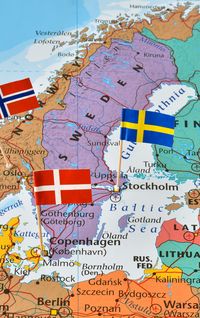Latin America's sovereigns have come a long way in a short space of time as far as ESG-related bonds are concerned. And far from any let-up, signs are that this universe will keep on expanding.
Ever since Chile issued the first sovereign green bond in Latin America in 2019, the region has been pushing to break new ground on sustainable debt issuance. At the start of last year, Ecuador issued the world’s first sovereign social bond, and then, in September, Mexico issued the first sovereign bond that is linked to the UN’s Sustainable Development Goals.
As governments in the region seek to rebuild their economies from the devastating impact of the coronavirus pandemic, social and sustainable bonds are likely to gain increasing traction as they seek to finance their recoveries.
Chile published its sustainable bond framework in November and followed that up in January with the region’s largest sovereign sustainability deal so far, raising US$4.25bn spread across four green and social bonds in both the dollar and European markets, issuing again at the end of March with a US$1.5bn sustainable bond in the Taiwanese market.
Brazil then published its sustainability bond framework in April, which suggests a deal could be imminent. Uruguay has been talking to investors about a potential sustainable bond, market watchers say. Others in the region are also likely to be eyeing deals.
“Last year, we had the first social bond from Ecuador, and we’re also working with a number other countries, for example Colombia, that are trying to get ready for this kind of sustainable issuance,” said Maria Netto, principal specialist in the Inter-American Development Bank’s connectivity, markets and finance division.
“It started more green, but because of fiscal pressures and the actions governments had to take because of Covid, they are now giving huge importance to social.”
Ecuador’s debut social bond in January 2020, which was backed by the IDB, raised the country US$400m to help extend its social housing programme – Casa Para Todos – to give those on low and middle-incomes access to cheaper mortgage financing.
Mexico’s deal in September then went a step further by linking its €750m bond to the UN’s SDGs, specifically targeting social goals. Those included providing production subsidies to small and medium-sized farmers, a variety of education and healthcare-related spending, financial inclusion programmes and developing rural roads.
“The Mexico deal does paint a slightly different story for the region,” said Robert White, head of the green and sustainable hub for the Americas at Natixis, which was the sole sustainability structurer on the deal.
“It has really unlocked the market. The rise of the social bond over the last year has had a really powerful impact for Latin America, that is not to ignore the environmental side but it is a part of the world where both stories need to be told and the market is ripe for both stories now.”
Part of the Mexican deal’s appeal for some investors was the fact the country worked with the UN Development Programme to identify the right SDGs and then how to separate out the spending in its budget that goes towards those SDGs. That was on top of the annual impact reporting and independent third-party opinions that typically accompany such issuance.
“We’ve been quite vocal in saying we thought that was best practice in the sustainable bond space,” said Graham Stock, emerging market senior sovereign strategist at BlueBay Asset Management.
“A lot of public sector spending, particularly in emerging markets is or should be aligned with the SDGs – most of the healthcare budget, most of the education budget, lots of infrastructure – so there should be scope for more of that type of issuance. We participated because we thought the bond was attractively valued, but we don’t have a specific mandate to buy SDG-linked bonds at any price.”
Mandates required
That lack of a specific mandate is one potential challenge the sustainable bond market in Latin America faces as it begins to grow. Few emerging market asset managers have dedicated funds to buy social, green or sustainable bonds, said Stock, and dedicated social or green funds might also be wary of investing in emerging markets or are unable to participate in transactions that are not use-of-proceeds bonds, where the money is designated for a particular project.
However, that could be a bonus for asset managers who buy now and hold while more dedicated funds are created.
“If you look at the new issue premium for green or social bonds, it’s marginal compared to the existing curve, which suggests there isn’t a new buyer base that is creating extra demand for these issues – it’s the same buyers,” said Stock.
“Over time, we think that buyer base will grow, so if we’re buying a bond now flat to the existing sovereign curve, we think over time it should outperform because there will be new mandates established that can only buy this kind of bond and therefore there will be additional demand.”
The growth of sustainability-linked bonds in the corporate debt market – where issuers commit to coupon step-ups if they miss their sustainability targets – has also had bankers and investors debating how this mechanism could work for sovereign issuers.
While Mexico’s bond links to the UN’s SDGs, it is not the same as a sustainability-linked bond, as there is no financial penalty for missing the targets. Uruguay, for instance, is said to have been looking at the potential for issuing an SLB, which would be a first for a sovereign – yet issuing such a bond would not be straightforward.
“Coupon step-ups are a bit harder to embark on as a sovereign because why should the general population ultimately have to pay higher taxes towards interest payments if the government failed to meet the objectives they set – that’s a little trickier to swallow,” said White.
“So the discussion at the moment is how you can come up with alternatives that can still provide incentives that give investors comfort around the seriousness, the materiality and the level ambition, while still having skin in the game. But as this market evolves, we shouldn’t just be thinking about the use-of-proceeds format, we should also be thinking about the sustainability-linked format.”
Just how much impact sustainable bonds can have on a region like Latin America, where even before the coronavirus pandemic struck roughly a third of the population lived in poverty, remains a work in progress.
“We’re still at an early stage, so it’s complicated to have a clear sense of what the real impact is on the overall economy because this is still a tiny part of the market,” said Julien Bras, a green bond fund manager at Allianz Global Investors.
“It will probably become more clear in three to five years, when we will have more data. But even if the growth in the market has been huge over the past two or three years, we were coming from such a low level that the overall size of the sustainable bond market is still only a small part of the overall capital markets.”
One area where it can have an immediate impact is on galvanising domestic support for sustainability issues.
“Sustainable bonds are a great public engagement tool that can help push positive change and impact by bringing awareness to specific problems – public buy-in is what helps drive positive change,” said Christina Cho, co-head of sustainable finance markets for the Americas at BNP Paribas.
“I’m a big fan of project finance to solve local problems – you can see where the money goes and the impact it can have.”
The IDB's Netto also reckons sustainable bonds and the impacting reporting required around them can motivate finance ministers to pay more attention to sustainability issues than would otherwise have been the case.
“Traditionally, these topics have not been led by finance ministries, but because those ministries have to start showing how their budgets or package of investments are meeting sustainability targets linked to their sustainable bonds, that is changing the way the finance ministries operate and helping them think in a different way and lead the agenda as well,” she said.
While investors are increasingly holding issuers to account over their sustainability efforts, many are also pragmatic about what can be achieved in emerging markets, where stringent targets might be harder to achieve than in developed countries.
“For us, the importance of the sustainability movement overall within our ESG framework is the engagement,” said Yerlan Syzdykov, global head of emerging markets and co-head of emerging markets fixed income at Amundi Asset Management.
“We can go out there and impose very strict rules on [emerging market borrowers] and deny them any access to financing until they become sustainable, but this is not the road for positive change. We have to be gradualistic and we need to allow for that divergence of sustainability to a certain extent and gently manage it towards more impactful sustainability goals.”
Syzdykov said that while social issues are endemic across emerging markets, Latin America’s struggles with income inequality and access to education are particularly entrenched. The region has also historically treated its indigenous communities poorly, especially in the context of developing mining and infrastructure projects– something that investors need to engage on.
“These are the areas from a human development perspective that are very important to us,” he said. “We need to create opportunity for transition, and engagement is the key word here versus exclusion.”
To see the digital version of this report, please click here
To purchase printed copies or a PDF of this report, please email gloria.balbastro@lseg.com




























